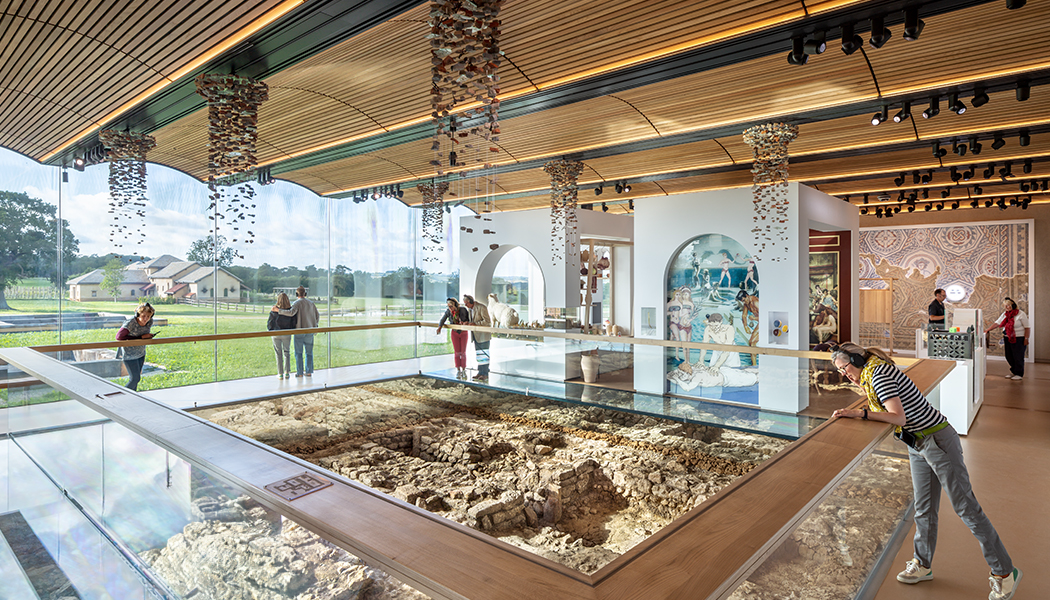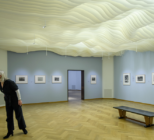The Roman Villa Museum in Somerset, UK, located on ‘The Newt’ estate, is a museum about Roman life in the English countryside in the year 351 AD. This privately funded project, located on the extensive estate, also includes a hotel, restaurant, beautiful garden, multiple museums, and a lifelike version of a Roman villa. Villa Ventorum has been partially excavated and can be visited in the museum.
The Roman Villa Museum is the latest addition to the estate. After Beezantium, a museum about bees, and The Story of Gardening, a museum about gardening, this exhibition was also designed by the design agency Kossmandejong. They approached a lighting design agency from their home base in Amsterdam, HeinzLoopstra Lightdesign, for the lighting designs in these beautiful museums. With decades of experience in creating lighting plans for museums, they know how to use light to make a space exciting and inviting. In this project, they have done so by using different LED modules than in the previously designed spaces.
For the lighting design of the first museum, the designers looked for a suitable lighting solution and decided on the CLS Jade. The designers had to have the approval of the owner for the use of this fixture. He finds aesthetics very important in these museums because the fixtures are entirely visible due to the abundance of daylight that enters the room. The Jade is now subsequently used in all three museums. Due to the near-endless possibilities, this fixture fits perfectly into the designers’ lighting plans. HeinzLoopstra: ‘The Jade can highlight small objects but also wallwash large walls. The accessories (honeycomb, barndoor & linear frost) make it possible to illuminate all aspects of an entire room with one type of spotlight.’
In the design of the Roman Villa Museum, the architect opted for a white back wall and a glass front, allowing plenty of daylight to enter the interactive space. The lighting designers aimed to ensure that the lighting perfectly matches the natural light at all times of the day. HeinzLoopstra: ‘In the daylight, we wanted the light to be cold white, so it blends well with the daylight outside. At dusk, the light fades within half an hour, so the change goes unnoticed by the visitor to a warmer evening setting. The owner likes warm light, and by choosing Tunable White LED modules, we could create different scenes based on the incoming daylight.’
To calculate the desired result in advance, they put the entire museum in Dialux, a lighting design software, to get a precise picture of the daylight in the museum. By importing the CLS Jade fixtures into the program, the designers could check the angles of the light and see how they could achieve the desired result. They could also see that the lux values of sunlight corresponded perfectly with the measured values in the museum. Through the renders, they convinced the estate owner of the Tunable White light modules, which are used in all 180 fixtures.
The modules and fixtures are programmed with a flexible DMX control system. That was the only logical solution for this project due to the amount of fixtures. HeinzLoopstra: ‘With DMX we could immediately see changes from the light computer, which allowed us to work fast when assigning the 180 fixtures.’ Fixtures close to the glass wall in the design are switched off during the day to save energy.
Although the lighting designers certainly succeeded in creating a beautiful lighting design in combination with the daylight, this also created a challenge. In addition, the layout of the museum was also a challenge, especially the wooden arches on the ceiling. The arches limited the space for all the installations that had to be placed here, including the light rails. HeinzLoopstra: ‘The fixed positions of the light rails were occasionally so restrictive that we could not properly illuminate a wall because the angle from the nearest rail was not good. The walls are also so high that they stopped half a meter below the light rails. The challenge for us was to illuminate these walls without them looking ‘spotty’ or having hotspots. That was particularly successful with the use of frost filters.’
However, the designers also indicate that these challenges and limitations made the project fun and that they and the customer are satisfied with the result. ‘It has become a beautiful exhibition. The contact with the glass facade and the ruins of the Roman Villa in the middle of the museum are gorgeous. In addition, we think it has been successful to allow the light to be an addition to the existing daylight and gradually let the fixture’s lighting become warmer as dusk falls. It transforms the entire atmosphere in the museum.’








